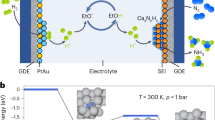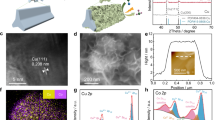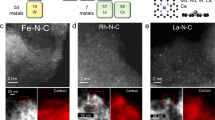Abstract
The dominant Haber–Bosch process to produce ammonia, arguably the most important chemical in support of global food supply, is both energy and carbon intensive, resulting in substantial environmental impacts. Electrocatalytic nitrogen reduction reaction (NRR) powered by renewable electricity provides a green synthetic route for ammonia, but still suffers from insufficient yield rate and Faradaic efficiency. Single-atom electrocatalysts (SACs) have the potential to transform this catalytic process; however, controllable synthesis of SACs with high loading of active sites remains a big challenge. Here we utilize bacterial cellulose with rich oxygen functional groups to anchor iron (Fe) and cobalt (Co), realizing high density, atomically dispersed, bimetallic Fe–Co active sites. For electrocatalytic NRR, our catalyst design delivers a remarkable ammonia yield rate of 579.2 ± 27.8 μg h−1 mgcat.−1 and an exceptional Faradaic efficiency of 79.0 ± 3.8%. The combined theoretical and experimental investigations reveal that the operando change in coordination configuration from [(O-C2)3Fe–Co(O-C2)3] to [(O-C2)3Fe–Co(O-C)C2] is the enabling chemistry. Our findings suggest a general approach to engineer SACs that can drive critical reactions of relevance for sustainability.
This is a preview of subscription content, access via your institution
Access options
Access Nature and 54 other Nature Portfolio journals
Get Nature+, our best-value online-access subscription
$29.99 / 30 days
cancel any time
Subscribe to this journal
Receive 12 digital issues and online access to articles
$119.00 per year
only $9.92 per issue
Buy this article
- Purchase on Springer Link
- Instant access to full article PDF
Prices may be subject to local taxes which are calculated during checkout





Similar content being viewed by others
Data availability
All data that support the findings in this paper are available within the article and its Supplementary Information. Source data are available from the corresponding author upon reasonable request.
References
Ye, L., Li, H. & Xie, K. Sustainable ammonia production enabled by membrane reactor. Nat. Sustain. 5, 787–794 (2022).
Lim, J., Fernández, C. A., Lee, S. W. & Hatzell, M. C. Ammonia and nitric acid demands for fertilizer use in 2050. ACS Energy Lett. 6, 3676–3685 (2021).
Yang, B., Ding, W., Zhang, H. & Zhang, S. Recent progress in electrochemical synthesis of ammonia from nitrogen: strategies to improve the catalytic activity and selectivity. Energy Environ. Sci. 14, 672–687 (2021).
Smith, C., Hill, A. K. & Torrente-Murciano, L. Current and future role of Haber–Bosch ammonia in a carbon-free energy landscape. Energy Environ. Sci. 13, 331–344 (2020).
Chang, F., Gao, W., Guo, J. & Chen, P. Emerging materials and methods toward ammonia-based energy storage and conversion. Adv. Mater. 33, 2005721 (2021).
Suryanto, B. H. R. et al. Nitrogen reduction to ammonia at high efficiency and rates based on a phosphonium proton shuttle. Science 372, 1187–1191 (2021).
Guo, X. et al. Direct, nonoxidative conversion of methane to ethylene, aromatics, and hydrogen. Science 344, 616–619 (2014).
Liu, P. et al. Photochemical route for synthesizing atomically dispersed palladium catalysts. Science 352, 797–800 (2016).
Lin, L. et al. Low-temperature hydrogen production from water and methanol using Pt/α-MoC catalysts. Nature 544, 80–83 (2017).
Cao, L. et al. Atomically dispersed iron hydroxide anchored on Pt for preferential oxidation of CO in H2. Nature 565, 631–635 (2019).
Wang, A., Li, J. & Zhang, T. Heterogeneous single-atom catalysis. Nat. Rev. Chem. 2, 65–81 (2018).
Zhang, L., Ren, Y., Liu, W., Wang, A. & Zhang, T. Single-atom catalyst: a rising star for green synthesis of fine chemicals. Natl Sci. Rev. 5, 653–672 (2018).
Wang, X. et al. Atomically dispersed Au1 catalyst towards efficient electrochemical synthesis of ammonia. Sci. Bull. 63, 1246–1253 (2018).
Chen, Y. et al. Highly productive electrosynthesis of ammonia by admolecule-targeting single Ag sites. ACS Nano 14, 6938–6946 (2020).
Tao, H. et al. Nitrogen fixation by Ru single-atom electrocatalytic reduction. Chem 5, 204–214 (2019).
Peng, W. et al. Spontaneous atomic ruthenium doping in Mo2CTX MXene defects enhances electrocatalytic activity for the nitrogen reduction reaction. Adv. Energy Mater. 10, 2001364 (2020).
Han, L. et al. Atomically dispersed molybdenum catalysts for efficient ambient nitrogen fixation. Angew. Chem. Int. Ed. Engl. 131, 2343–2347 (2019).
Hui, L. et al. Highly efficient and selective generation of ammonia and hydrogen on a graphdiyne-based catalyst. J. Am. Chem. Soc. 141, 10677–10683 (2019).
Han, L. et al. Local modulation of single-atomic Mn sites for enhanced ambient ammonia electrosynthesis. ACS Catal. 11, 509–516 (2021).
Liu, J. et al. Rare earth single-atom catalysts for nitrogen and carbon dioxide reduction. ACS Nano 14, 1093–1101 (2020).
Zang, W. et al. Copper single atoms anchored in porous nitrogen-doped carbon as efficient pH-universal catalysts for the nitrogen reduction reaction. ACS Catal. 9, 10166–10173 (2019).
Zhang, S. et al. Electrocatalytically active Fe-(O-C2)4 single-atom sites for efficient reduction of nitrogen to ammonia. Angew. Chem. Int. Ed. Engl. 59, 13423–13429 (2020).
Wang, M. et al. Over 56.55% Faradaic efficiency of ambient ammonia synthesis enabled by positively shifting the reaction potential. Nat. Commun. 10, 341 (2019).
Zhang, L. et al. A Janus Fe-SnO2 catalyst that enables bifunctional electrochemical nitrogen fixation. Angew. Chem. Int. Ed. Engl. 59, 10888–10893 (2020).
Li, J. et al. Accelerated dinitrogen electroreduction to ammonia via interfacial polarization triggered by single-atom protrusions. Chem 6, 885–901 (2020).
Su, H. et al. Single atoms of iron on MoS2 nanosheets for N2 electroreduction into ammonia. Angew. Chem. Int. Ed. Engl. 59, 20411–20416 (2020).
Zhang, S. et al. Laser irradiation in liquid to release cobalt single-atom sites for efficient electrocatalytic N2 reduction. ACS Appl. Energy Mater. 3, 6079–6086 (2020).
Mukherjee, S. et al. Atomically dispersed single Ni site catalysts for nitrogen reduction toward electrochemical ammonia synthesis using N2 and H2O. Small Methods 4, 1900821 (2020).
Wang, J. et al. Design of N-coordinated dual-metal sites: a stable and active Pt-free catalyst for acidic oxygen reduction reaction. J. Am. Chem. Soc. 139, 17281–17284 (2017).
Wang, J. et al. Synergistic effect of well-defined dual sites boosting the oxygen reduction reaction. Energy Environ. Sci. 11, 3375–3379 (2018).
Ren, W. et al. Isolated diatomic Ni-Fe metal-nitrogen sites for synergistic electroreduction of CO2. Angew. Chem. Int. Ed. Engl. 58, 6972–6976 (2019).
Lu, Z. et al. An isolated zinc-cobalt atomic pair for highly active and durable oxygen reduction. Angew. Chem. Int. Ed. Engl. 58, 2622–2626 (2019).
Wang, X. et al. Confined Fe-Cu clusters as sub-nanometer reactors for efficiently regulating the electrochemical nitrogen reduction reaction. Adv. Mater. 32, 2004382 (2020).
Han, L. et al. Modulating single-atom palladium sites with copper for enhanced ambient ammonia electrosynthesis. Angew. Chem. Int. Ed. Engl. 60, 345–350 (2021).
Zeng, P. et al. Enhanced catalytic conversion of polysulfides using bimetallic Co7Fe3 for high-performance lithium-sulfur batteries. ACS Nano 14, 11558–11569 (2020).
Chen, G. et al. Alumina-supported CoFe alloy catalysts derived from layered-double-hydroxide nanosheets for efficient photothermal CO2 hydrogenation to hydrocarbons. Adv. Mater. 30, 1704663 (2018).
Fuchs, D. et al. Tuning the magnetic properties of LaCoO3 thin films by epitaxial strain. Phys. Rev. B 77, 014434 (2008).
Oshikiri, T., Ueno, K. & Misawa, H. Selective dinitrogen conversion to ammonia using water and visible light through plasmon-induced charge separation. Angew. Chem. Int. Ed. Engl. 55, 3942–3946 (2016).
Choi, J. et al. Identification and elimination of false positives in electrochemical nitrogen reduction studies. Nat. Commun. 11, 5546 (2020).
Tong, Y. Y., Rice, C., Wieckowski, A. & Oldfield, E. A detailed NMR-based model for CO on Pt catalysts in an electrochemical environment: shifts, relaxation, back-bonding, and the Fermi-level local density of states. J. Am. Chem. Soc. 122, 1123–1129 (2000).
Andersen, S. Z. et al. A rigorous electrochemical ammonia synthesis protocol with quantitative isotope measurements. Nature 570, 504–508 (2019).
Suryanto, B. H. R. et al. Challenges and prospects in the catalysis of electroreduction of nitrogen to ammonia. Nat. Catal. 2, 290–296 (2019).
Liu, S. et al. Proton-filtering covalent organic frameworks with superior nitrogen penetration flux promote ambient ammonia synthesis. Nat. Catal. 4, 322–331 (2021).
Wang, M. et al. Salting-out effect promoting highly efficient ambient ammonia synthesis. Nat. Commun. 12, 3198 (2021).
Greenlee, L. F., Renner, J. N. & Foster, S. L. The use of controls for consistent and accurate measurements of electrocatalytic ammonia synthesis from dinitrogen. ACS Catal. 8, 7820–7827 (2018).
Kibsgaard, J., Nørskov, J. K. & Chorkendorff, I. The difficulty of proving electrochemical ammonia synthesis. ACS Energy Lett. 4, 2986–2988 (2019).
Li, L. et al. Two-dimensional mosaic bismuth nanosheets for highly selective ambient electrocatalytic nitrogen reduction. ACS Catal. 9, 2902–2908 (2019).
Hao, Y.-C. et al. Promoting nitrogen electroreduction to ammonia with bismuth nanocrystals and potassium cations in water. Nat. Catal. 2, 448–456 (2019).
Kresse, G. & Furthmüller, J. Efficient iterative schemes for ab initio total-energy calculations using a plane-wave basis set. Phys. Rev. B 54, 11169–11186 (1996).
Kresse, G. & Furthmüller, J. Efficiency of ab-initio total energy calculations for metals and semiconductors using a plane-wave basis set. Comput. Mater. Sci. 6, 15–50 (1996).
Kresse, G. & Hafner, J. Ab initio molecular-dynamics simulation of the liquid-metal-amorphous-semiconductor transition in germanium. Phys. Rev. B 49, 14251–14269 (1994).
Blöchl, P. E. Projector augmented-wave method. Phys. Rev. B 50, 17953–17979 (1994).
Perdew, J. P., Burke, K. & Ernzerhof, M. Generalized gradient approximation made simple. Phys. Rev. Lett. 77, 3865–3868 (1996).
Monkhorst, H. J. & Pack, J. D. Special points for Brillouin-zone integrations. Phys. Rev. B 13, 5188–5192 (1976).
Azofra, L. M., Li, N., MacFarlane, D. R. & Sun, C. Promising prospects for 2D d2–d4 M3C2 transition metal carbides (MXenes) in N2 capture and conversion into ammonia. Energy Environ. Sci. 9, 2545–2549 (2016).
Acknowledgements
H.Z. acknowledges funding support from the Natural Science Foundation of China (grant no. 52172106 and 51872292). M.H. acknowledges funding support from the Natural Science Foundation of China (grant no. 61804154). Y.L. acknowledges funding support from the Natural Science Foundation of China (grant no. 52122212), Youth Innovation Promotion Association of the CAS (grant no. 2020458) and National Key Research and Development Program of China (grant no. 2019YFA0307900). S.Z. acknowledges funding support from Anhui Provincial Natural Science Foundation (grant no. 2108085QB60), CASHIPS Director’s Fund (grant no. YZJJ2021QN18), China Postdoctoral Science Foundation (grant no. 2020M682057) and Special Research Assistant Program, Chinese Academy of Sciences. This work is also supported by the CAS/SAFEA International Partnership Program for Creative Research Teams of Chinese Academy of Sciences, China. This work was carried out with the support of 1W1B beamline at Beijing Synchrotron Radiation Facility. The computation work was carried out at LvLiang Cloud Computing Centre of China and the DFT calculations were performed on TianHe-2.
Author information
Authors and Affiliations
Contributions
H. Zhao and H. Zhang conceived the concept and designed the experiments. S.Z. fabricated the catalysts and performed the material characterization and electrochemical measurements. M.H. conducted DFT calculations. L.R.Z. carried out the EXAFS measurements and T.S. analysed the EXAFS results. Y.L. performed the STEM measurements. X.Z., H. Zhou, C.C., Y.Z., G.W. and H.Y. contributed to the experimental design. H. Zhao and H. Zhang supervised the research. H. Zhao, H. Zhang and S.Z. co-wrote the manuscript. All authors discussed the results and commented on the manuscript.
Corresponding authors
Ethics declarations
Competing interests
The authors declare no competing interests.
Peer review information
Peer review information
Nature Sustainability thanks Rui Si and the other, anonymous, reviewer(s) for their contribution to the peer review of this work.
Additional information
Publisher’s note Springer Nature remains neutral with regard to jurisdictional claims in published maps and institutional affiliations.
Supplementary information
Supplementary Information
Supplementary Figs. 1–39, Tables 1–6 and refs. 1–69.
Rights and permissions
Springer Nature or its licensor (e.g. a society or other partner) holds exclusive rights to this article under a publishing agreement with the author(s) or other rightsholder(s); author self-archiving of the accepted manuscript version of this article is solely governed by the terms of such publishing agreement and applicable law.
About this article
Cite this article
Zhang, S., Han, M., Shi, T. et al. Atomically dispersed bimetallic Fe–Co electrocatalysts for green production of ammonia. Nat Sustain 6, 169–179 (2023). https://doi.org/10.1038/s41893-022-00993-7
Received:
Accepted:
Published:
Issue Date:
DOI: https://doi.org/10.1038/s41893-022-00993-7
This article is cited by
-
Atomically dispersed materials: Ideal catalysts in atomic era
Nano Research (2024)
-
Oxygen-Coordinated Single Mn Sites for Efficient Electrocatalytic Nitrate Reduction to Ammonia
Nano-Micro Letters (2024)



